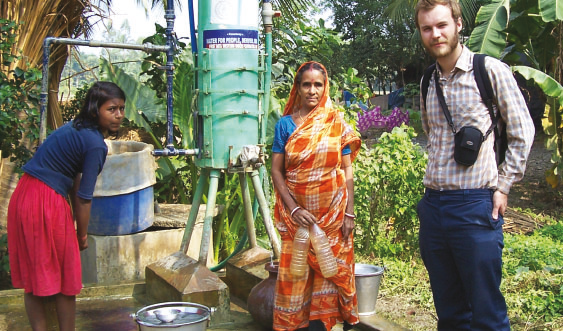The world’s worst environmental catastrophe is yielding one village at a time to a homegrown solution developed by Arup SenGupta, professor of civil and environmental engineering.
SenGupta’s filtration system, which removes arsenic from water at the wellhead, has been installed in more than 150 villages in Eastern India since 1997.
The World Health Organization estimates that as many as 100 million people in India and Bangladesh drink well water containing toxic levels of arsenic. Victims suffer skin lesions, cancer and even death. WHO calls the phenomenon the “largest mass poisoning of a population in history.”
In villages where SenGupta’s system has been installed, arsenic levels in well water have fallen from 100 to 500 parts per billion to well below the 50-ppb maximum allowed by the Indian government. Victims have found relief from symptoms, and new cases of arsenicosis have plummeted.
The filtration systems are built in India and installed by students and faculty from India’s Bengal Engineering and Science University. Cost of installation ranges from $1,200 to $1,500 and is usually paid by villagers. The systems are operated with a hand pump and require no electric power or chemicals. They are maintained by village committees with help from the university.
SenGupta was asked to tackle the arsenic crisis in 1995 by Water For People, a nonprofit group. Working with Luis Cumbal, who earned a Ph.D. from Lehigh in 2004, he learned to “impregnate” columns of tiny, polymeric ion-exchange beads with ferric hydroxide nanoparticles. The iron transmits its affinity for arsenic to the beads. The beads provide a sturdy mechanism for the fine iron powder, which would otherwise clump and clog the column, making arsenic removal inefficient or impossible. The result is a hybrid sorbent that removes arsenic from water.
SenGupta, a native of Calcutta, believes environmental problems in developing countries often respond best to indigenous solutions.
In 2002, writing in the Journal of the Institution of Chemical Engineers, SenGupta said, “Our attempts to solve the environmental woes of the ‘developing’ countries with solutions from the ‘developed’ ones have often been unsatisfactory, if not disastrous.”
In February 2007, SenGupta and his research team, which includes Lehigh students and Bengal University faculty, received the Silver Award in the National Academy of Engineering’s Grainger Challenge for Sustainability. The award carried a cash prize of $200,000.
In April 2007, SenGupta and his Lehigh students won a $75,000 award from the U.S. Environmental Protection Agency’s P3 (People, Prosperity and the Planet) competition for a project that will involve the safe disposal of sludge containing high levels of arsenic. The group plans to build a reactor and disposal site in the Indian state of West Bengal.

